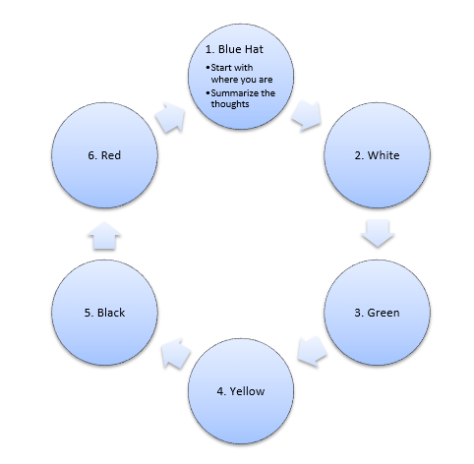Introduction
Edward De Bono coined up the notion of six thinking hats – each one of them metaphorically defines a certain type of thinking. The main purpose of this thinking is to promote parallel thinking by enabling people to think different aspects of the common purpose.
As part of this thinking framework you can expect following
- It is cooperative
- People involve don’t argue
- Everyone wear different hats
- Everyone builds on the thinking of others
- The process is constructing and exploring (repeat if needed)
Six Hats
| Hat Name | Description |
|---|---|
| White Hat (Facts) | The facts, figure, data & information – known or needed – in a neutral and objective way. After wearing this hat you focus directly on the information – what is available, what is needed, what is missing and how it might be obtained – without judging, interpreting, debating them. |
| Yellow Hat (Sunshine) | For a given set of facts, this hat calls for optimism, positivity, benefits, feasibility and how something can be done. |
| Black Hat (Critic) | Consider your proposals critically and logically – to reflect on why a suggestion does not fit the facts, the available experience, or the system in use. You bring in caution by thinking of aspects like cost, design, regulation, materials, team, models, safety issues, etc. While this hat does help you in avoiding disaster, using too often and too early may kill creativity. |
| Red Hat (Emotions) | This hat allows you to bring in intuition, gut-feelings, likeness, hunches and emotions aspects into your thinking – without the need for justification, explanation or apology. |
| Green Hat (Creative) | The green hat is specifically concerned with innovation, creating new ideas (alternatives) and new ways (possibilities) of looking at things, different ways to explain the facts, vegetation, growth, energy, modifications, etc. It basically asks for the creative effort – without thinking about recognition, judgement and criticism. |
| Blue Hat (Cool) | Controls the sequence / process of thinking and it is also called thinking about the thinking. Basically, it summarizes the thoughts and lists out action items – ensures productivity by asking for a summary, conclusion, or decision.The common questions are – what should we do, what we have done, what do we want to achieve, what have we learned, what may supplement, what next, etc. |
Guidelines while using Six Hat
- Start with blue hat and give each hat 2-3 minutes
- Repeat the sequence if needed
- Certain hat can be skipped if desired
Following Sequence is often helpful
While any specific order is not so critical, if you are a seasoned thinker using this framework, it is good to keep Black (critics) and Red (emotions) towards end.
Audio Books
Part One
Part Two
